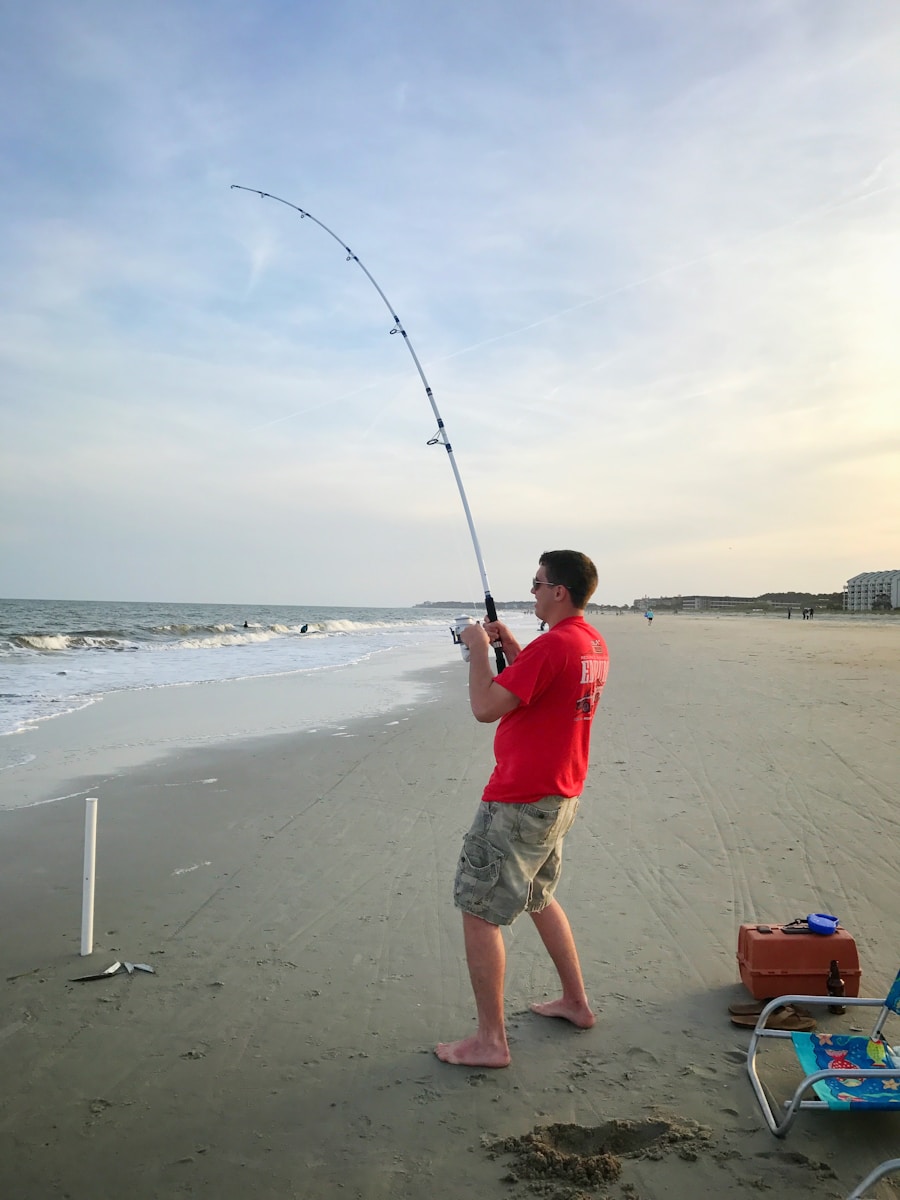Download links
How to install The Thrill of Ocean Fishing: A Guide to Catching Big Game APK?
1. Tap the downloaded The Thrill of Ocean Fishing: A Guide to Catching Big Game APK file.
2. Touch install.
3. Follow the steps on the screen.
Description
Ocean fishing, often referred to as big game fishing, is an exhilarating pursuit that draws anglers from all walks of life. This form of fishing typically targets larger species such as marlin, tuna, and swordfish, which are not only challenging to catch but also provide a thrilling experience on the open water. The allure of big game fishing lies in the combination of skill, strategy, and the sheer excitement of battling with some of the ocean’s most formidable creatures.
Understanding the behavior and habitats of these fish is crucial for any angler looking to improve their chances of a successful catch. The ocean is a vast and dynamic environment, and the species that inhabit it are influenced by various factors, including water temperature, currents, and seasonal migrations. For instance, many big game fish are migratory, traveling long distances in search of food or spawning grounds.
Knowledge of these patterns can significantly enhance an angler’s ability to locate and catch these fish. Additionally, understanding the feeding habits of target species can inform decisions about bait selection and fishing techniques. For example, yellowfin tuna are often found near schools of smaller fish, so using live bait or lures that mimic these prey can be particularly effective.
Key Takeaways
- Understanding the Big Game
- Ocean fishing involves targeting large game fish such as marlin, tuna, and swordfish.
- These big game fish require specialized equipment and techniques for successful fishing.
- Essential Gear and Equipment
- Essential gear includes heavy-duty rods and reels, strong fishing line, and a variety of lures and baits.
- Safety equipment such as life jackets, first aid kits, and communication devices are crucial for ocean fishing.
- Choosing the Right Location
- Researching and selecting the right location is key to a successful ocean fishing trip.
- Factors to consider include the presence of the target species, weather conditions, and accessibility to the fishing spot.
- Techniques for Successful Ocean Fishing
- Techniques such as trolling, chumming, and deep sea fishing are commonly used for targeting big game fish.
- Understanding the behavior and feeding patterns of the target species is essential for successful fishing.
- Safety Tips for Ocean Fishing
- Always check weather conditions and sea forecasts before heading out for an ocean fishing trip.
- Properly maintaining and inspecting all gear and equipment is crucial for ensuring a safe and successful fishing trip.
- Responsible Fishing Practices
- Practicing catch and release for certain species helps in preserving the ocean’s ecosystem.
- Adhering to fishing regulations and size limits is important for sustainable fishing practices.
Essential Gear and Equipment
When it comes to big game fishing, having the right gear is paramount. The equipment used can make the difference between a successful outing and a frustrating day on the water. A sturdy rod and reel combination designed for heavy-duty fishing is essential.
Typically, anglers opt for rods that are at least 6 to 7 feet long, with a high line capacity to handle the weight and strength of large fish. Reels should be equipped with a strong drag system to withstand the powerful runs of big game species. Many anglers prefer conventional reels for their durability and ability to handle heavy line.
In addition to rods and reels, other essential gear includes high-test fishing line, which is often braided for its strength and sensitivity. A line with a test strength of 50 to 130 pounds is common for targeting larger species. Terminal tackle such as hooks, swivels, and leaders must also be chosen carefully; using strong, corrosion-resistant materials is crucial due to the harsh saltwater environment.
Furthermore, having a selection of lures and bait is vital. Live bait such as mackerel or squid can be particularly effective, while artificial lures that mimic the movement of prey can also entice big game fish.
Choosing the Right Location

Selecting the right location for ocean fishing is a critical factor that can greatly influence success rates. Different species of big game fish prefer specific habitats based on their feeding habits and environmental conditions. For instance, many anglers find success in areas where underwater structures such as reefs or wrecks are present, as these locations often attract baitfish and, consequently, larger predators.
Additionally, fishing near current lines or tidal rips can be advantageous since these areas tend to concentrate fish. Another important consideration is the time of year. Many species have specific migration patterns that coincide with seasonal changes in water temperature and food availability.
For example, bluefin tuna are often found in certain regions during their spawning season in late spring and early summer. Researching local fishing reports and consulting with experienced anglers or charter captains can provide valuable insights into the best locations during different times of the year. Utilizing technology such as fish finders can also aid in identifying promising spots by detecting underwater structures and schools of fish.
Techniques for Successful Ocean Fishing
| Technique | Success Rate |
|---|---|
| Trolling | 60% |
| Bottom Fishing | 70% |
| Chumming | 50% |
| Drift Fishing | 65% |
Mastering various fishing techniques is essential for success in big game fishing. One popular method is trolling, which involves dragging lures or bait behind a moving boat at varying speeds. This technique allows anglers to cover large areas of water while enticing fish that are actively hunting.
Trolling can be particularly effective for species like marlin and tuna, which are known for their aggressive feeding behavior. Adjusting the speed and depth at which lures are presented can help mimic the natural movement of prey. Another effective technique is chunking, which involves cutting bait into small pieces and dispersing them in the water to create a scent trail that attracts fish.
This method is particularly useful when targeting species like yellowfin tuna or mahi-mahi. Anglers often use a combination of live bait and chunks to increase their chances of attracting larger fish. Additionally, vertical jigging has gained popularity among big game anglers; this technique involves dropping heavy jigs straight down into the water column and retrieving them with quick jerks to mimic injured prey.
Safety Tips for Ocean Fishing
Safety should always be a top priority when engaging in ocean fishing. The open sea can be unpredictable, and being prepared for various conditions is essential for ensuring a safe experience. One of the most critical safety measures is wearing a life jacket at all times while on the boat.
Even experienced anglers can find themselves in precarious situations due to sudden weather changes or equipment failures. Additionally, it’s advisable to have a well-stocked first aid kit on board to address any minor injuries that may occur during the trip. Understanding weather patterns and monitoring forecasts before heading out is equally important.
Sudden storms can arise without warning, so being aware of changing conditions can help anglers make informed decisions about their safety. Furthermore, having reliable communication devices such as VHF radios or satellite phones can be invaluable in case of emergencies. It’s also wise to inform someone on land about your fishing plans, including your expected return time, so they can alert authorities if you do not return as scheduled.
Responsible Fishing Practices

As stewards of the ocean, anglers have a responsibility to practice sustainable fishing methods that protect marine ecosystems for future generations.
These regulations are designed to ensure that fish populations remain healthy and sustainable over time.
Anglers should familiarize themselves with these rules before heading out and keep accurate records of their catches. Catch-and-release practices are also an important component of responsible fishing. When targeting species that are overfished or vulnerable, using techniques that minimize stress and injury to the fish can help maintain population levels.
This includes using barbless hooks for easier removal and handling fish with wet hands or gloves to protect their slime coating. Additionally, educating fellow anglers about sustainable practices can foster a culture of conservation within the fishing community, ensuring that future generations can enjoy the thrill of big game fishing while preserving the health of our oceans.
If you’re interested in ocean fishing, you may also enjoy reading about the popular mobile game Mario Kart Tour. Check out this article to learn more about the exciting features and gameplay of this fun racing game.
FAQs
What is ocean fishing?
Ocean fishing, also known as deep sea fishing, is the practice of catching fish and other marine species in the open ocean. It typically involves fishing in waters that are deeper than 30 meters.
What types of fish can be caught through ocean fishing?
A wide variety of fish can be caught through ocean fishing, including tuna, marlin, swordfish, mahi-mahi, snapper, grouper, and many others. The specific types of fish that can be caught depend on the location and the time of year.
What equipment is typically used for ocean fishing?
Ocean fishing often requires specialized equipment such as deep sea fishing rods and reels, heavy-duty fishing line, and large hooks. Additionally, boats equipped with fish finders, GPS, and other navigation tools are commonly used for ocean fishing.
Where are popular ocean fishing destinations?
Popular ocean fishing destinations include the Gulf of Mexico, the Caribbean Sea, the Pacific Ocean, and the Atlantic Ocean. Specific locations within these regions, such as the Florida Keys, Cabo San Lucas, and the Great Barrier Reef, are known for their excellent ocean fishing opportunities.
What are the regulations and restrictions for ocean fishing?
Regulations and restrictions for ocean fishing vary by location and can include limits on the number and size of fish that can be caught, as well as restrictions on certain species to protect their populations. It is important for ocean fishermen to be aware of and comply with these regulations to ensure sustainable fishing practices.





